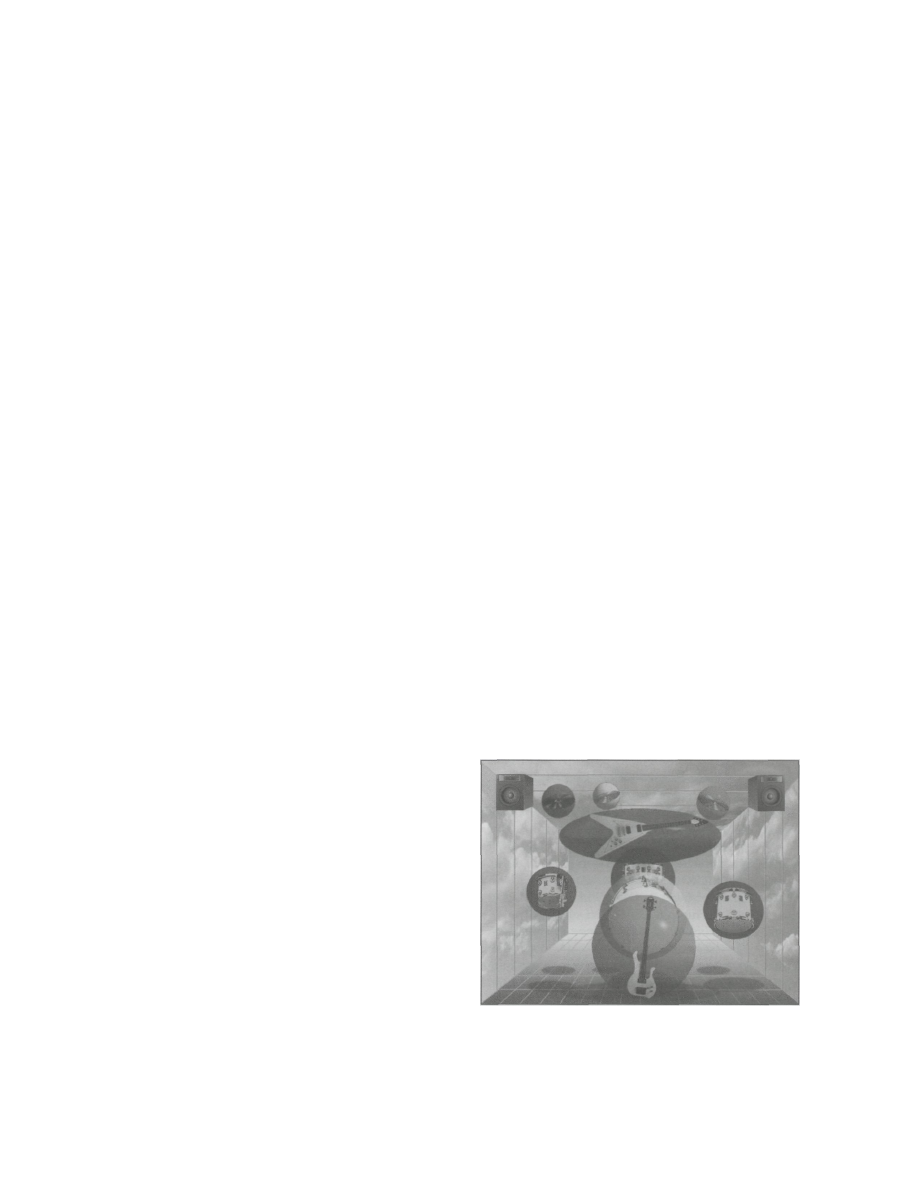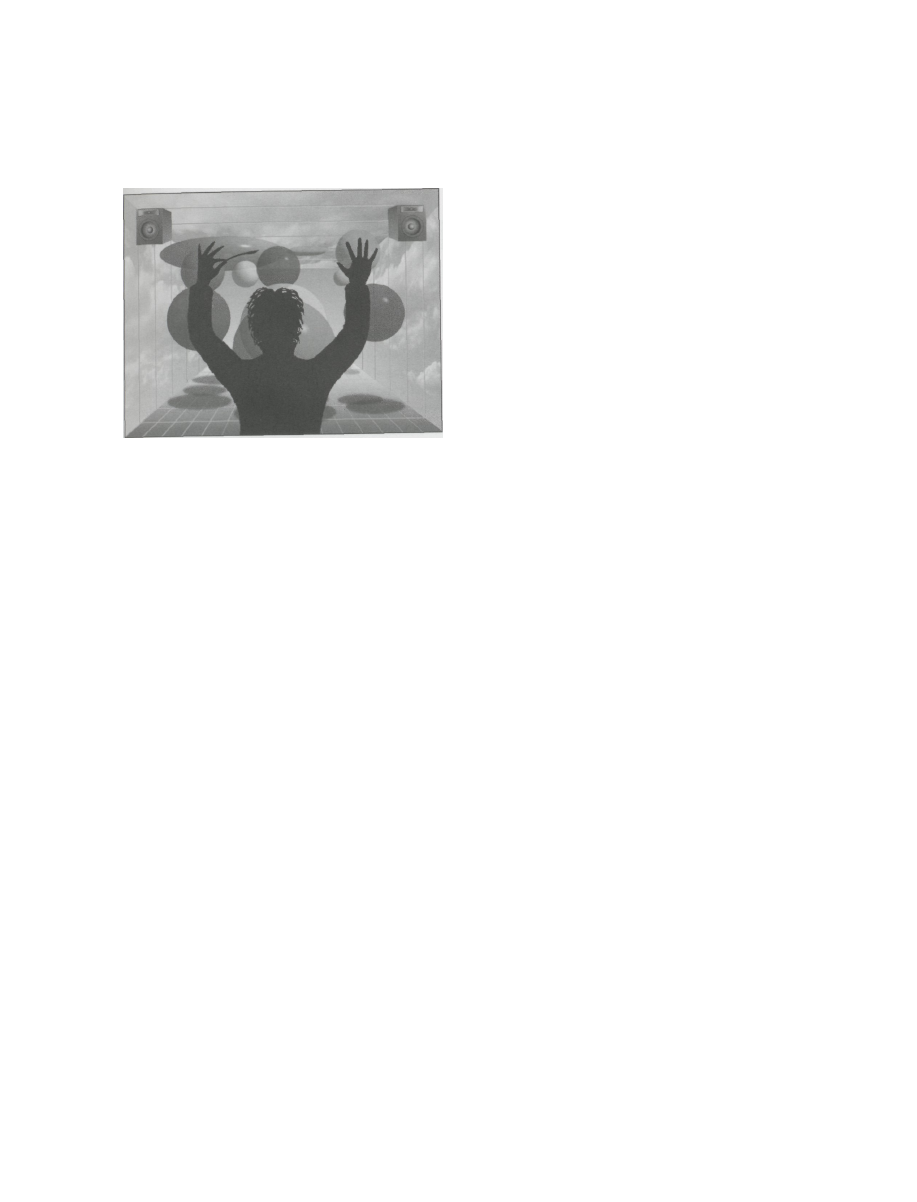ВУЗ: Казахская Национальная Академия Искусств им. Т. Жургенова
Категория: Книга
Дисциплина: Не указана
Добавлен: 03.02.2019
Просмотров: 8058
Скачиваний: 204

Preface
This book has been designed to answer the elusive
questions, "What makes a great mix?" and "How do
you go about creating a great mix?" Although most
people know what they like, they often don't know
how to achieve what they want when they're in the
studio.
To answer these questions, I explain and use
visual representations of sounds as a tool for under-
standing the whole world of dynamics that an engi-
neer can create with the equipment in the studio.
It's easy to learn the function of each piece of
equipment in the studio; you can read user's manuals
or the tons of good books available that explain the
equipment. The difficulty lies in knowing how to use
the equipment and learning what combinations of
equipment are used to create great sounding mixes.
Once you know what the knobs do, which way do you
turn them?
In other fields of art, there is no shortage of
books that attempt to explain the whole world of aes-
thetics. From music to finger painting, scholars have
tried answering the question, "What makes great art?"
But recording is a relatively new field, and very little
has been written about the aesthetics of mixing.
This is one of the first books that attempts to
explain the aesthetic side of creating a great mix.
This is no simple feat, as there are many musical styles
based on any number of different instruments, all of
which are recorded differently. Each style of music
has its own world of values that are changing con-
stantly. The number of variations is endless. Perhaps
no one has attacked this complex subject of mixing
due to the lack of a framework to analyze the process.
Without a framework, it is difficult to explain what is
going on and hard to remember all the different
things that can be done in a mix. In music, music the-
ory provides this framework. This book introduces a
framework for understanding everything that engi-
neers do in mixing.
The primary goal of this book is to give you a
perspective on how the equipment works together to
create every mix in the world. Once you have a per-
spective on what can be done, you can be truly cre-
ative on your own.
It has been said that there are no rules when it
comes to recording. After all, the perfect mix to one
person may be the worst mix to another. However,
most bands want mixes that sound like their style of
music, and for some styles of music—such as big band,
acoustic jazz, and even certain types of rock 'n' roll—
the rules are actually quite strict.
In the recording industry, there are certain
high-level values that are commonly held. We know
this because there are certain professional engineers
who can create a great mix every time they sit in front
of a console. These engineers command exorbitant
fees because they are capable of coming up with
something that most people perceive as great, every
time. So what is it they are doing? It isn't magic. They
are only doing some very specific things. If you could
simply understand and learn what they do, you could
start down the path to becoming a great engineer.
Getting there might be a long process—but once you
know where you're going, you'll get there faster! And
once you understand what the successful engineers
are doing, you can create your own style. This book
will help you develop and recognize your own values
through visuals, because visuals help us to remember.
After all, a picture is worth a thousand sounds.
Visual 1. Sound Imaging (see color Visual 1C)
This book will help you discover the high-level
values that major engineers have and help you do
the most difficult job of all: make art out of technol-
ogy. The recording engineer makes the relationship
X

between the equipment dynamics and the musical
dynamics work. This is the art of mixing.
Visual 2. Structuring Mix (see color Visual 2C)
xi

Acknowledgments
There is a wide range of people that helped me along
the way to this point where I am writing this book.
The truth is that in this book I have simply gathered
together a large amount of information from a huge
number of contacts and sources—and then there are
those divine inspirations, and who knows where they
come from?
First, I probably would have never gotten into
this business without the suggestion of my brother
Bill. He was the first to say, "Ever thought about being
a recording engineer?" Then, there were my various
music instructors and all of my recording instructors,
including Bob Beede and John Barsotti. There was
also Herbert Zettl, whose book on video aesthetics
helped to inspire the structure of this book. Craig
Gower was also another inspiring force in learning
about working with music. And then there was
Chunky Venable who was kind enough to have the
faith in me to run his studio even though I was so
green.
There are also those various artists, engineers,
and producers who have influenced my values on this
long road. Everybody from Pink Floyd to Bob Clear-
mountain have made a huge impression on my
recording and mixing values.
A very special thanks goes to my dear friend
Steven Rappaport, who was there at the inception of
this book. He spent many hours looking over rough
manuscripts, brainstorming over various ideas and
concepts, and encouraging me to go forth with the
project.
I would especially like to thank those who spent
the time to read through earlier versions of the book
at no cost: David Schwartz, Charlie Albert, Fred Catero,
Roy Pritz, Bob Ezrin, and Thomas Dolby. A special
thanks to Fred for his exuberant and detailed critique
of the book. Extra thanks to Thomas for his evangel-
ical support of the whole visual paradigm.
Thanks are in order to Todd Stock, who has
helped with editing and been a spiritual advisor of
sorts. Thanks to Archer Sully, who has been helping
to bring into reality an actual working version of the
Virtual Mixer. Thanks also to Silicon Graphics for
their support and for loaning me an Indigo 2 com-
puter. Thanks go to Donna Compton for helping with
the rough editing of the earlier version of the book.
Thanks go to Fred Mueller for much of his graphics
work on the book. Extra thanks go to Melissa Lubof-
sky for her visual inspirations and dedicated work in
creating many of the graphics, as well as her patient
efforts in helping me to learn Photoshop so I could
do many of the visuals on my own. Thanks also to
Alon Clarke for his enthusiasm and creativity with the
photography.
And then there is Patrice Newman who has
spent so many hours by my side, giving me emotional
support, helping me with rough edits, and critiquing
the visuals.
Much appreciation goes out to all of the gang at
Mix Bookshelf for their extremely helpful, creative,
and professional support: Mike Lawson, George Peter-
sen, Lisa Duran, and Linda Gough.
And finally, I would be amiss if I didn't thank all
of my students from over the years for the innumer-
able suggestions and inspirations that they have
brought to me. They are the real reason for this book.
May this book begin an ongoing dialogue about what
makes a great mix, to light the way for students in the
future, so none of us are "all mixed up" ever again.
xiii

Introduction
This book is designed to explain how to create great
mixes. However, the mix is only one aspect of what
makes a great recording. Other factors also contribute
to what is perceived as a quality recording and mix.
Chapter 1
"All Aspects of a Recorded Piece of Music" begins by
covering the eleven aspects of a great recording: con-
cept, melody, rhythm, harmony, lyrics, arrangement,
instrumentation, song structure, performance, qual-
ity of the equipment/recording, and the mix.
Each of these aspects must be at least of basically
good quality. If even one of them isn't, the recording
will suffer. The mix is only one of the eleven aspects,
but it is one of the most powerful because it can hide
some of the weaker aspects or highlight the magic in
the stronger aspects.
In the first chapter, we explore what the record-
ing engineer can do to help refine each of these com-
ponents. The rest of the book continues with what
can be done with only the aspect of the mix.
Chapter 2
"Visual Representations of 'Imaging' " introduces the
visual framework for representing "imaging," the
apparent placement of sounds between the speakers.
Section A shows the difference between the per-
ception of physical sound waves coming out of the
speakers and the imagined perception of imaging.
This is important because the two are sometimes con-
fused, and the visuals represent only imaging, not
physical sound waves.
Section B introduces volume, frequency, and
panning visually and then defines the boundaries of
imaging (the limited space where a mix occurs
between the speakers).
Section C explains how and why specific visuals
were chosen for each sound and effect in the studio.
Chapter 3
"Guides to a Great Mix" explains all of the reasons for
creating one style of mix or another.
Section A explains how the style of music affects
the way a song is mixed.
Section B describes how the song and all of its
details dictate the way a song is mixed. It goes
through every detail within a song and explains how
each aspect might affect the placement of volume,
EQ, panning, and effects.
Section C discusses how the people involved—
the engineer, the band, the producer, and the mass
audience—contribute to the way a song is mixed. It
explains the most difficult job of all for the engineer:
to take the values, suggestions, and ideas of everyone
involved in a project; decide which ones are best for
the project; then diplomatically work with everyone
to bring about the best recording and mix possible. It
also covers the extraordinary human dynamics that
go into balancing the values of everyone involved.
Chapter 4
"Functions of Studio Equipment and Visual Repre-
sentations of All Parameters" utilizes the images out-
lined in Chapter 2 to describe the function of each
piece of studio equipment in the mix. It briefly, but
technically, explains what each piece of equipment
does. (As you will see, the visuals make the details of
complex functions easily understandable.)
Section A explains the basic functions of faders,
compressor/limiters, and noise gates and how to set
them for different instruments in various styles of
music and songs.
Section B explains the differences between vari-
ous types of equalizers—graphics, parametrics, and
rolloffs—and describes all the frequency ranges
found in sounds.
Besides the individual frequencies, it is also
important to understand how different frequencies
work together to create sounds, or timbres. This har-
monic structure is the basic building block of sound.
It is important because when you use an equalizer,
you are changing the harmonic's volume in that
sound.
Most importantly, this section gives you a step-by-
step process for using an equalizer to make something
sound good—or just the way you want it to sound!
Section C covers the basics of left to right place-
ment in a mix.
xiv

Section D describes each of the common func-
tions and parameters of delays, flangers, choruses,
phase shifters, reverbs, and harmony processors.
At this point, all of the details of the equipment
will have been covered visually. Now the visual repre-
sentations will be utilized to show how all of the
equipment is used together to create different styles
of mixes.
Chapter 5
"Traditions and Common 'Musical Dynamics' Cre-
ated With Studio Equipment" first discusses the dif-
ferent dynamics found in music and the incredibly
wide range of possible dynamics that different people
perceive in music, including feelings and emotions;
thought forms; psychological, physiological, and
physical reactions; visual imagery; cultural and even
spiritual connotations.
The mixing board and the rest of the equipment
in the studio can also create musical and emotional
dynamics. Therefore, the engineer must not only
know what all of the equipment does but he or she
must also become familiar with the dynamic complex-
ities that can be created with the equipment in a mix.
This chapter embarks on an in-depth survey of
how each piece of equipment in the studio creates
musical and emotional dynamics based on the style of
music, the song and its details, and what the people
want. The chapter begins by defining the three levels
of dynamics that can be created with each of the tools
in the control room—volume, EQ, panning, and ef-
fects. Then it describes each tool in the control room,
explaining what it does based on three levels of
dynamics for volume, equalization, panning, and
time-based effects: individual placement and relative
settings, patterns of placement, and changing settings.
Once you see all that can be done with the
equipment in the studio, a whole new world will open
up for you
Chapter 6
"Styles of Mixes" is an exploration of the dynamics
that can be created with all of the equipment
together. It explains how high-level dynamics can be
created using combinations of a variety of multiple
settings.
Once you have created a context or a particular
style of mix, the most intense dynamic that can be
created is to completely change all of the settings on
all of the equipment at once to create a completely
different type of mix or context. There is nothing so
intense and powerful when it comes to engineering.
This chapter discusses that technique.
Chapter 7
"The Relationship of Musical Dynamics Created by
Equipment to the Musical Dynamics Found in Music
and Songs" is designed to set you on your way in this
lifelong exploration of all of the relationships
between the dynamics you can create in a mix and
the dynamics that are found in music. After all, rela-
tionships are what it's all about.
At this point, you will have a framework for under-
standing and remembering all that can be done in a
mix. You can then use this framework to understand
exactly what engineers are doing in the mix of every
song you hear. Ask yourself, "Do I like what they are
doing?" And after a while, you will develop your own
style and you can confidently do whatever you want.
xv